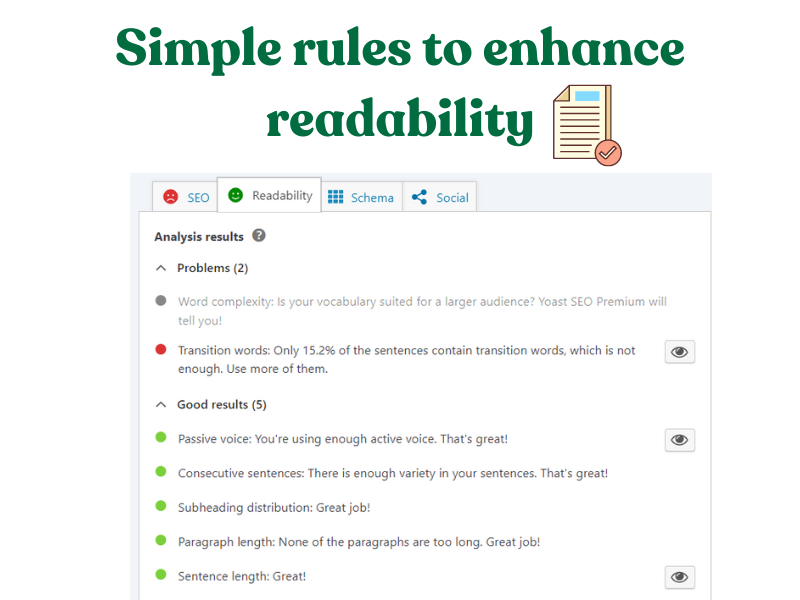Introduction: Why Readability Matters for Your Content
Ever wondered why some articles keep readers hooked while others are quickly skimmed and forgotten? The secret lies in readability. High readability keeps readers engaged, improves comprehension, and leads to better user experience.
In today’s sea of millions of articles, the rise of AI-generated content, especially ChatGPT-produced articles, has made it challenging to maintain readability. Many of these AI-generated pieces tend to lack the flow and clarity that human readers prefer, making it increasingly difficult to find well-crafted, digestible content amidst the overwhelming amount of automated output.
Let’s break down simple rules to enhance readability, with actionable tips that anyone can use to transform their content into engaging, clear, and reader-friendly material.
1. Break It Down with Short Sentences and Paragraphs
Long sentences? Overstuffed paragraphs? These are readability killers. Break up your text into bite-sized chunks to improve flow and make it more digestible.
- Aim for sentences that are 15-20 words long.
- Stick to paragraphs of 3-4 sentences.
- Keep each idea clear and contained to one paragraph.
Example:
Instead of “We are a company that specializes in multiple fields including SEO, digital marketing, and web development, providing top-notch services to clients worldwide,” try:
“We specialize in SEO, digital marketing, and web development. Our services help clients globally.”

2. Use Bullet Points and Lists to Simplify Complex Information
Whenever you’re explaining a step-by-step process or listing options, use bullet points or numbered lists. This makes your content scannable and helps readers digest information quickly.
- Break complex instructions into clear steps.
- Highlight important features in a bulleted list.
- Keep each bullet point concise, no more than two lines.
3. Use Clear, Simple Language: Ditch the Jargon
Your readers aren’t looking for a vocabulary lesson. They want to understand your content quickly without feeling like they’re decoding a secret language. Keep it simple.
- Use everyday language.
- Avoid industry-specific jargon unless necessary.
- When you need to use a complex term, explain it briefly.
4. Choose Readable Fonts and Formatting
Font choice and size matter. Use a clean, easy-to-read font (like Arial, Helvetica, or Georgia) and ensure it’s large enough to be comfortable on all devices.
- Font size: 16px for body text is optimal.
- Line spacing: Use 1.5 or 2.0 for better readability.
- Contrast: Ensure there’s enough contrast between the text and background (dark text on a light background is ideal).
If you are still unsure how to create content will full readaility score, you can outsource a copywriter that can help you.
5. Leverage Headers and Subheaders (H1, H2, H3)
Organizing your content with headers isn’t just for SEO—it’s essential for readability. Break your content into sections with relevant headers and subheaders to guide your reader through the material.
- Start with an H1 for the title.
- Use H2 for major sections.
- H3 and H4 can be used for sub-points under those sections.
6. Add White Space: Give Your Text Room to Breathe
White space (the empty areas between your text and images) improves focus and reduces visual fatigue.
- Leave enough space between paragraphs and sections.
- Use white space to separate important ideas and make your content easier to scan.
7. Engage Readers with a Conversational Tone
The days of robotic, corporate-sounding content are over. Readers want to feel like they’re having a conversation with a real person.
- Use “you” and “we” to create a dialogue.
- Avoid passive voice and formal language.
- Share personal experiences and relatable stories to keep things engaging.
Example:
“You’ve probably struggled with writing long paragraphs that lose the reader halfway through. Trust us, we’ve been there too.”
8. Sprinkle in Visuals and Interactive Elements
Adding visuals like images, infographics, and charts can help break up text and reinforce your points. They also improve comprehension.
- Include images to clarify or illustrate complex topics.
- Use infographics to present data in an easy-to-understand format.
- Incorporate videos where appropriate to keep readers engaged.
Incorporate videos where appropriate to keep readers engaged. Consider using resources like A Visual Guide to Keyword Targeting and On-Page SEO.
9. Use Transition Words to Guide Readers
Help your readers follow your train of thought by using transition words. These bridge the gap between sentences and paragraphs, making the content flow naturally.
- Use words like “first,” “next,” and “finally” for lists.
- Try “however,” “on the other hand,” and “as a result” to connect contrasting points.
10. Don’t Forget the Call-to-Action (CTA)
Every piece of content should end with a clear, actionable next step. Whether it’s to read more articles, sign up for a newsletter, or explore a product, the CTA should be bold and obvious.
- Place CTAs at the end of articles and in between sections if relevant.
- Use action-oriented language like “Discover,” “Learn More,” or “Get Started.”
FAQs
Q: How can I measure the readability of my content?
A: You can use tools like Grammarly, Hemingway Editor, or the Flesch-Kincaid readability test to evaluate your content’s readability score.
Q: Does readability affect SEO rankings?
A: Yes, readability impacts SEO because content that is easy to read often keeps users on the page longer and reduces bounce rates.
Q: Can visuals really improve readability?
A: Absolutely. Visuals break up large blocks of text and make complex information more digestible, which enhances overall readability.
Conclusion: Readability as the Key to User Engagement
Improving readability isn’t just about making content more pleasant to read—it’s about creating a better user experience, encouraging engagement, and improving your SEO performance. By implementing these simple rules, you’ll ensure your content not only ranks but also speaks to your readers.
Remember, the easier it is for people to read and understand your content, the more likely they are to stay, share, and return for more.
